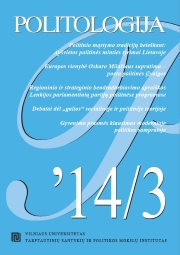DEBATAI DĖL „GALIOS“ SOCIALINĖJE IR POLITINĖJE TEORIJOJE
THE POWER DEBATE IN SOCIAL AND POLITICAL THEORY
Author(s): Vytautas IsodaSubject(s): Politics / Political Sciences
Published by: Vilniaus universiteto leidykla & VU Tarptautinių santykių ir politikos mokslų institutas
Summary/Abstract: Power is one of the basic, but at the same time one of the most disputed concepts in political science, as well as other social sciences contiguous to it. The dispute over the meaning of power is best instantiated by the ongoing debate between political scientists and sociologists which started around 1960s – the so-called “faces of power debate”. Although different conceptions of arguably the same phenomenon where termed “faces of power” relatively recently by the scientists taking part in this debate, these conceptions have their roots in various paradigmatic social and political theories, and methodological traditions (Weberian comparative historical sociology, structural functionalism, critical theory and Gramscian neomarxism, structuration theory, Foucaultian post-structuralism, etc.). Therefore, the first task of this theoretical endeavour is to overview the faces-of-power literature in the context of the long-established social scientific traditions in order to trace the intellectual roots of the four faces. A strong case can be made for associating the first face of power with behaviourism, the second – with structural functionalism of Talcott Parsons and structurationism of Anthony Giddens, the third – with critical social theory and Gramscian neomarxism, whereas the fourth face of power is exclusively inspired by the works of Michel Foucault. At the end, a modest “taxonomy” of power is proposed with relative weight of social conflict / social consensus, subjectivity / objectivity of interests, and the source of power serving as axes for differentiation among different conceptions (faces). The second section focuses on the conceptual limits of “power” and its discursive relation to “authority” and “coercion” (meaning “physical force”). Drawing on the theoretical insights of Talcott Parsons, Hannah Arendt and Anthony Giddens, authoritative power is associated with the full institutionalisation and legitimation of relations of autonomy and dependence between a position of authority and its subordinate; therefore, as an ideal type, authoritative power by definition involves voluntary acquiescence and faces virtually no opposition. In contrast, a relation (or rather an act) of coercion involves no active part of the subject (or rather object) over whom it is exercised. Along these lines, a strong argument can be made that physical coercion is not a form of power. It does not involve a minimum amount of dialectic of control associated with power relations. “Authority” and “coercion” are thus seen as conceptual markers, the former corresponding to the maximum of power and the latter – to a complete absence of power, which is replaced by a causal chain of sheer physical force and its consequence in a Newtonian sense.
Journal: Politologija
- Issue Year: 2014
- Issue No: 3 (75)
- Page Range: 86-108
- Page Count: 23
- Language: Lithuanian

